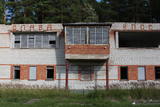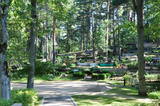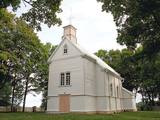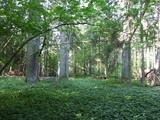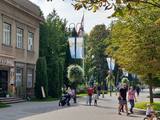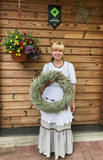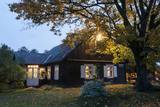| Нo | Название | Описание |
|---|---|---|
|
Тир в Скуйниеки использовался для летних занятий по стрельбе, обучения стрельбе и тренировок. В наше время тир часто используется для нужд Министерства обороны. На территории сохранилось построенное в 1982 году здание руководства с надписями на русском языке: «Слава КПСС» (Слава Коммунистической партии Советского Союза).
|
||
|
This study tour is designed to show Latvia's rye traditions as their central focus. This tour has been developed in cooperation with the Latvian Bakers’ Association. Rye is both the basis of the Latvian diet and a powerful symbol of Latvia's culture and culinary traditions. Itinerary emphasize traditional rye bread-baking and eating, as well as insights into the history of the rye grain from Latvia's earliest archaeological record to the present day. Itinerary include visits to working farms, grain mills and culturally and historically important locations. This study tour is designed for groups and may be adapted to the needs, interests and timeframe of each client. Tour cost includes meetings with experts, site visits and admissions, accommodations, specified meals, sightseeing, transportation within Latvia and guides-interpreters. |
||
|
Кладбище на этом месте (Сигули) существует уже с 1773-го года. На Царникавском кладбище покоится выдающийся народный поэт Оярс Вациетис (1933 – 1983), где ему поставлен памятник. Можно также осмотреть каплицу Царникавского имения, построенную в 18-м веке и надгробие арендатора имения Фалка. |
||
|
This is an area that is full of legend and tale. There is a stiff hillock, which stands about 66 metres above the surrounding land. From its southern side, you can see the Burtnieki lowlands. The tower, however, is not open to the public.
|
||
|
The trail tells about grey dunes which have survived thanks to the border restrictions and the presence of military. The trail starts from the parking place at the mouth of the Užava river. It is one of the few natural rivermouths in Europe. One can also see the „tacis”, an industrial installation for lamprey (Lampetra fluviatilis) fishing during their spawning migration period. The 3km long trail is circular. It winds for 1.5km from the Užava rivermouth to the North, along the coastline (the beach is covered with sand and pebbles), and returns to the starting point by a gravel road through grey dunes. Along the trail, one can observe a distinct white dune with rare plant species Linaria loeselii, Lathyrus maritimus, Anthyllis arenaria, Tragopogon heterospermus. About 1km from the rivermouth, in the sea, one can see a wrack of a sailing ship (parts of frame). The visibility depends on the flow of sand in the sea. The way back opens a beautiful view of the range of grey dunes. Unfortunately, Scots Pine starts taking over the area. There are three important biotopes of EU significance: „Fixed dunes with herbaceous vegetation 2130”, „Decalcified fixed dunes with Empetrum nigrum 2140” and „Dunes with Salix arenaria 2170”, forming a unique mosaic. Typical species here: mountain Alison ‘(Alyssum gmelinii), Pasqueflower (Pulsatilla pratensis), Sand Pink (Dianthus arenarius), Rosemary Leaved Willow (Salix rosmarinifolia), Dark Red Helleborine (Epipactis atrorubens), Kinnikinnick (Arctostaphylus uva-ursi). As a former military site, some military constructions can be seen here like horseshoe-shaped sand ramparts by the road in gray dunes. They were built to disguise military vehicles in case of sea attack. By the Kangroti graveyard, towards the Užava river, there is an underground pillbox. It is a one-man fortification to fire along the coastal perimeter. The Mouth of River Užava walking route is in the nature reserve „Užava” |
||
|
Eine einzigartige Kirche mit einem im 17. Jh. beiseite gebauten Glockenturm. |
||
|
Учащимся до 6 класса предлагаются экскурсии, во время которых проводится ознакомление с животными, разрешается их покормить или покататься на них верхом. Для более старших учеников рассказывают об эволюции и биологии лошадей, о работе с ними. Также предлагаются турпоходы по окрестностям по несложным маршрутам. |
||
|
On this hiking route you will see the most part of the western coast of Estonia from Pärnu to Tallinn. You will visit Estonia’s most popular resort cities: Pärnu and Haapsalu. You will pass along many bays, cape horns, fishermen’s villages and overgrown meadows. In the northern part you will walk along the spectacular Pakri cliffs, where you will see some of the most beautiful scenery in the area. There will also be sandy beaches and dolomite outcrops in places. In some rocky and wet sections you will use coastal forests and trails. During the route, you will see the Soviet military heritage in Paldiski. |
||
|
Пушский Римско-католический костёл Пресвятой Троицы
был построен в 1743 году на средства помещика Шадурскиса и
передан на попечение иезуитов. Пушский приход был основан в
Миссии иезуитов (миссией Шадурскиса). Костёл имеет три
алтаря и орган латышского органостроителя Я. Гремзе.
|
||
|
This is the thickest European Ash (Fraxius excelsior) in Latvia and the Baltic States. The homestead where the tree is found is the memorial museum of the painter Ģederts Eliass, and for that reason, the tree is sometimes also known as the Eliass ash tree.
|
||
|
Viena no ciema augstākajām būvēm. Koka vējdzirnavas cēla 1930. g. un ar vēja palīdzību darbināja septiņus gadus (vēlāk ar elektromotoru). Pie dzirnavām atrodas Jūrmalciema tūrisma informācijas punkts, stends un atpūtas vieta. Turpat redzami veco, zvejnieku pamesto liellaivu koka korpusi. |
||
|
The Ukri forest on the border of the Dobele district is what is known as a vast forest. It has oak trees (including many huge ones), linden trees, oak trees (large stands of oak are uncommon in Latvia), and other deciduous trees. A small area of the forest can be toured in the company of a guide to look at the animals of the area and their importance in the flow of nature. The restricted area protects forest habitats, plants and animals, including many that are typical of the southern areas of Latvia. |
||
|
Находится недалеко от железнодорожной станции. В подвальном этаже размещен цех кулинарии, на первом - магазин и кафе. Выпекают одноэтажные, многоэтажные торты, пирожные (слоеное пирожное, яблочное пирожное, «Вецрига», медовый пирог, эклеры, рулеты), булочки (с корицей, маком, ватрушки), пирожки (сырные рожки и рауши, рауши с салом, «Рижские рауши») и крендели, готовят мясные тарелки и соленые закуски. |
||
|
Ebenso kann man den Stolz des Hofe besichtigen, den Keller mit einer großen Kollektion im Hof erzeugter Weine. Im Hof kann man neben Wein auch diverse Obstweine aus Apfel, Kirsche, Schwarzer Johannisbeere, Moosbeeren, Rhabarber oder Stachelbeeren kaufen. |
||
|
Auf dieser Tour genießen Sie die Vielfalt der Natur im Lahemaa National Park - dem ältesten Nationalpark im Baltikum. Lahemaa - bedeutet auf Estnisch „das Land der Buchten“. Es zeichnet sich durch viele Buchten, Halbinseln, Wälder und Dörfer aus, die reich an kulturellem Erbe sind. Der Forest Trail führt entlang der Buchten und Halbinseln des Lahemaa-Nationalparks und führt die Wanderer in das bedeutendste Natur- und Kulturerbe ein. Die Wälder sind im Herbst reich an Blaubeeren und Pilzen und die Luft ist sehr sauber. Sie beginnen die Tour von Tallinn aus mit dem Bus zum Lahemaa National Park, wo Sie in einem der wunderschönen Herrenhäuser übernachten. Am nächsten Tag wandern Sie bis Oandu. Unterwegs sehen Sie Altja - ein malerisches traditionelles Fischerdorf, in dem sich eine traditionelle estnische Taverne befindet und Sie traditionelle Gerichte genießen können. In Oandu befindet sich das Besucherzentrum der Estnischen Staatlichen Waldbewirtschaftung (RMK), in dem Wanderer mehr über Waldlebensraumtypen und Waldbewirtschaftungstraditionen erfahren können. Dann erreichen Sie die Halbinsel Käsmu mit ihren bewaldeten Dünen und moosbedeckten Felsenfeldern, die das Gefühl vermitteln, in einem Märchen zu sein. Käsmu ist auch ein beliebtes estnisches Seekapitänsdorf. Dort können Sie das Meeresmuseum und den Leuchtturm besuchen sowie einen zusätzlichen Spaziergang zu den Vana-Jüri-Felsen unternehmen. Tagsüber sehen Sie von Käsmu nach Kasispea einige der beeindruckendsten Felsbrocken im Lahemaa-Nationalpark, die Felsbrocken Tammispea und Jaani-Tooma, die riesigen Monolithen ähneln. Sie beenden die Tour im Dorf Viinistu, wo wir Ihnen empfehlen, das Kunstmuseum von Viinistu zu besuchen. |
||
|
Die archäologischen Ausgrabungen zeugen davon, dass die Ufer des Flusses Ogre von Liven bewohnt waren. Zu einer größeren Ortschaft und zu einem bedeutenden Kurort entwickelte sich Ogre nach dem Ausbau der Eisenbahn Rīga-Daugavpils im Jahr 1861. Bis zum Ersten Weltkrieg haben in der Stadt Ogre ihre Dienstleistungen ungefähr 300 Sommerhäuser angeboten, die während des Krieges hauptsächlich zerstört wurden. Das nächste ‘große‘ Ereignis geschah im Jahr 1965, als in Ogre eine der in Europa größten Wirkwarenfabriken gebaut wurde, wo Gastarbeiter aus Vietnam und anderen Ländern arbeiteten. Heute hat die Stadt ihren Ruf als ein Kurort nicht wiedererlangt, aber sie ist zu einem ziemlich exklusiven Ort für den Bau von Privathäusern geworden. |
||
|
Diese Schänke befindet sich in dem Haus des Verwalters des Landgutes von Koknese und ist im Namen des lettischen Novellenschreibers Rudolfs Blaumanis genannt worden, der auf dem Landgut gelernt und hier zwei Jahr gelebt hat. Lettische Küche: Gemischter Salat Rasols, Heringssalat, Bohnensalat, Salat der Stadt Valmiera, Zwiebelklops, Schweinrippen, hausgemachte Frikadellen, Braten im Meerrettichsoße, gebratene Leber, Hering mit Quark, geschichtetes Haferflocken-Dessert. Das besondere Gericht: Scheibe des Schänkwirtes. |
||
|
Die Bäckerei befindet sich 0,3 km südlich von dem Herrenhaus des Landgutes von Malnava. Die Wirtin bereitet nahrhafte lettgallische Gerichte vor und bietet ländliche Leckereien an. Gäste können zuschauen, wie Torten und Piroggen gebacken werden. Das Brot von Dzīles ist ein Symbol von Karsava. Hier werden der Brunch – das späte Frühstück – angeboten und kleine Märkte der lokalen Heimarbeiter und Handwerker organisiert. Lettische Küche: Lettgallischer Speck, Graupengrütze mit Zutaten, gefüllte Kartoffel mit Speck und Zwiebeln, geschmorte Gemüse mit Fleisch, Beerenbrot, Tee mit Honig. Das besondere Gericht: Selbstgebackenes Brot von Dzīles, dessen Teig Kleien, Rosinen, Moosbeerenmarmelade und Leinsamen beigefügt werden. |
||
|
"Silene" - this is a recreation park, available at any time of the year! Recreation park "Silene" offers everything you need for an unforgettable holiday: accommodation in holiday houses or well-equipped rooms, relaxing SPA procedures, delicious food of the restaurant "Silenes Terraces", exciting attractions and active events for both adults and children. The park offers villas with all amenities, free WiFi and private parking. Next to the villas is the hotel "Sila Villa" with cozy rooms. |
||
|
Stūrīši is a homestead owned by the Taisel family, offering a collection and a chance to taste Liv foods: fish soup, porridge, sprat sandwiches, pastries, etc. |
||
